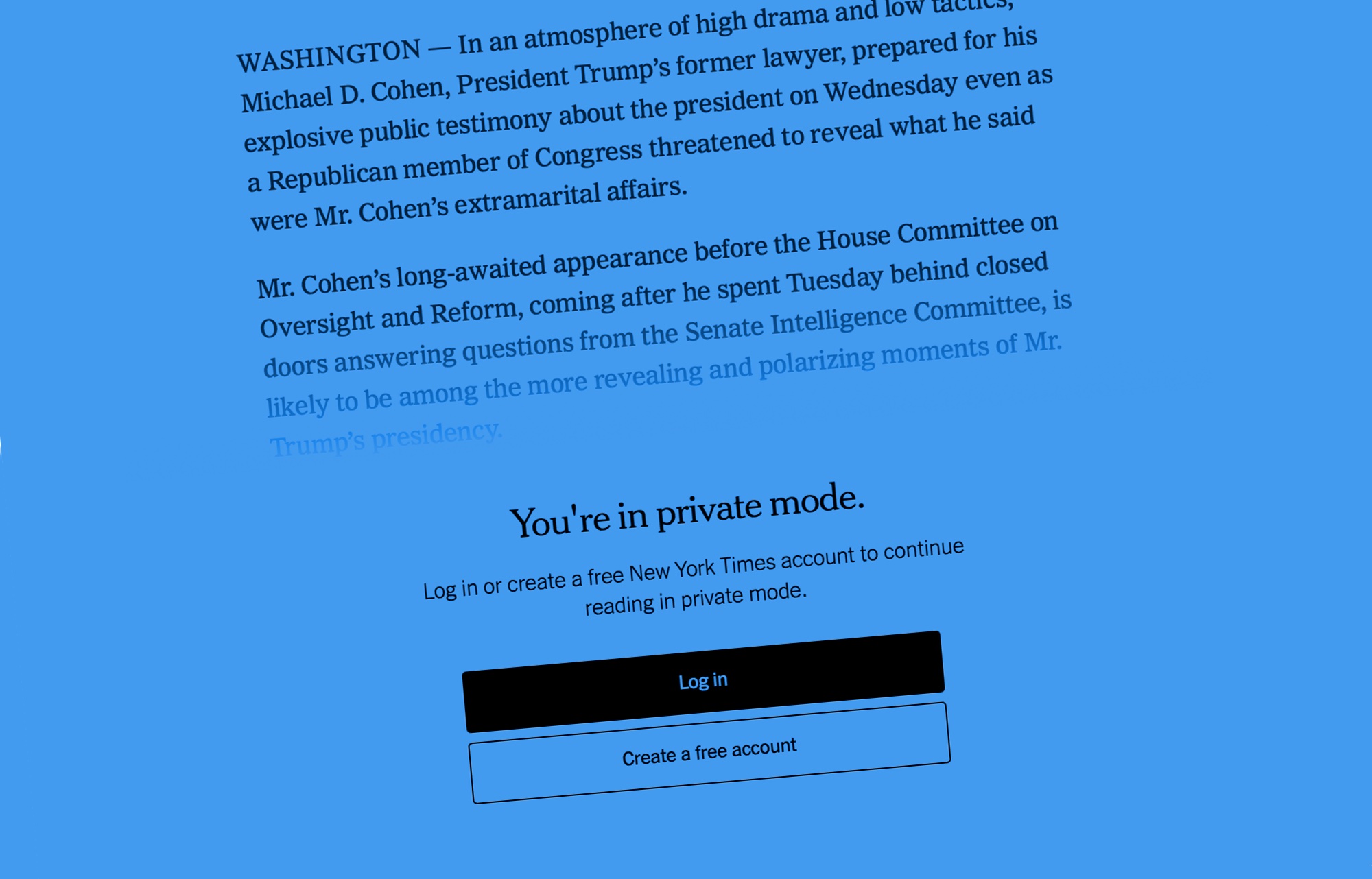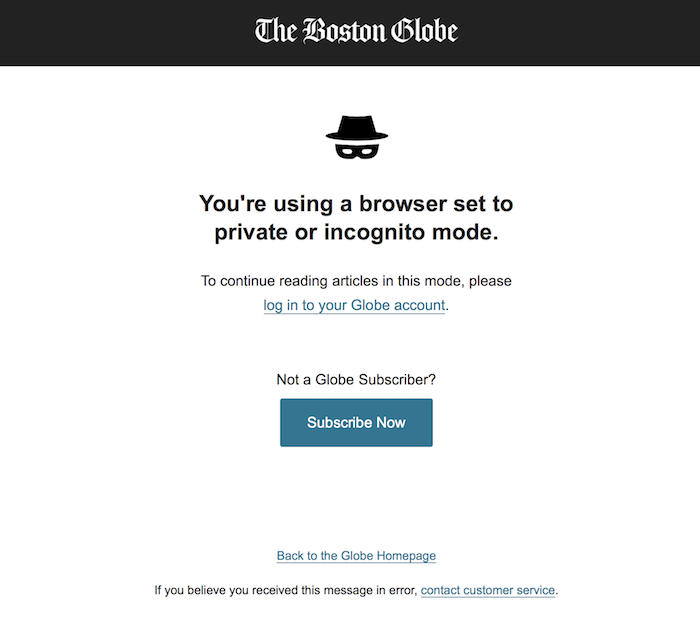
As long as The New York Times has had a metered paywall — it’s coming up on eight years! — people have been trying to sneak around it. While the paper has since had huge success getting millions of people to pay for digital news, it didn’t take long for people to realize that there was a pretty easy way to bypass it. (Innocent children unaware of this method: Cover your eyes and go play on TikTok or something.)
Google Chrome's incognito mode… or as I like to call it "NY Times paywall vaulter mode".
— J Herskowitz (@jherskowitz) January 18, 2013
Switching your web browser to incognito mode — that’s Chrome’s name for it; it’s Private Browsing in Safari and Firefox — temporarily blocks a site’s ability to read or write cookies on your device, and cookies are most typically how a subscription site knows whether you’re a paying customer or not. If you put all of your content behind a hard paywall — always requiring a login to get access — incognito mode isn’t a big worry. But if you have a metered paywall — where the same content is freely available in some circumstances but not in others — incognito mode essentially resets the meter every time.
For all manner of paywall avoiders — tapped-out college students, information-wants-to-be-free ideologues, people who just need that one story — incognito mode has been a godsend.
My husband just showed me that you can skirt nytimes article views using an incognito window in chrome. For now at least @NeuroPolarbear
— CoR (@CackleofRad) April 11, 2013
It's a great article, but it's behind a paywall. If you don't subscribe, you can open the link in an "incognito window" using your browser.😉
— Puesto Loco™ (@PuestoLoco) February 19, 2019
Using @Google incognito to bypass paywalls on @nytimes instead of looking at porn is peak millennialism.
— Danny Gutierrez (@GutiNation) February 22, 2019
1. Clicks @nytimes link.
2. "You've reached your limit on free articles"
3a. Copies URL. Opens new incognito window…
3b. NM, didn't care anyway.
Paywalls, folks. 👏
— Nathaniel Whittemore (@nlw) September 14, 2018
shoutout to the NYTimes’ paywall for doubling as a hard stop on the number of hate-reads I do in a given month.
this pop-up now basically reads “is it worth going into incognito mode just to get trolled by us?”
the answer is nearly always no. pic.twitter.com/xkQ6s5fE6B
— meritocracy killjoy (@polumechanos) March 23, 2018
me, opening an incognito window when a website has a paywall pic.twitter.com/zlqLNCw5RA
— A.B. (@honestabes) March 8, 2018
Me when I hit the paywall on a news site, then open up the link in an Incognito window to get around it pic.twitter.com/7XEQa2bw4W
— ℙ (@PatsHoppedUp) November 14, 2018
Even former editors-in-chief of Wired are into it! (I’d say Chris Anderson — a former journalist and current CEO of a drone company — should just pay up. But he did write a book called Free: The Future of a Radical Price, after all. Available now, $9.99 for Kindle.)
Thank you Google for providing Incognito Mode so I can get around the NYT paywall. If there any other uses for it, I am unaware of them
— Chris Anderson (@chr1sa) October 19, 2017
But in the past few days, a few people have noticed that the old trick may be on its last legs. I first noticed when Andréa López tweeted about it:
Look who cares when you're in private mode, now. pic.twitter.com/BaawSuqdmW
— Andréa López (@bluechoochoo) February 26, 2019
But she’s not alone.
Who told the @nytimes about incognito mode? 😒 pic.twitter.com/YmOTJncQxk
— Rebecca Day (@RebeccaDay93) February 26, 2019
Reading nytimes articles for free in incognito is over…
— Panos Vouzis (@pvouzis) February 27, 2019
My biggest nightmare has come true: not being able to access NYTimes in an incognito mode while running out of free articles. pic.twitter.com/XVKCWuPyN3
— Tisa (@ticooi) February 27, 2019
Wait, the @nytimes finally figured out the opening the article in incognito mode trick??? 😡😡😡
— Miles (@FormerlyMiles) February 25, 2019
well i can't defy the NY Times article limit by going incognito anymore there is no god
— olivia (@oliviaa_bushh) February 19, 2019
While I am, of course, an upstanding member of proper society and a Times subscriber in good standing, I was able to duplicate what these folks are seeing in Safari on my Mac — the first couple of grafs of a story fading into the digital equivalent of “we’re on to you and your schemes, bub”:

But while I was able to trigger it, not everyone in the office was, which made me suspect it’s an internal test the Times was running, affecting some visitors but not all. I reached out to the Times, and a spokesperson confirmed it — it’s a test, not a permanently implemented change. (For now, at least.)
The Times would not be the first publisher to make this change. The first I noticed, almost two years ago, was The Boston Globe, but today the Los Angeles Times, The Dallas Morning News, and others send a similar message to private browsers.



This sort of move is in line with a general trend toward tighter paywalls. The Times paywall debuted in 2011 with 20 free articles a month; that number’s now 5. It’s now not uncommon for a local or metro paper to allow only 1 or 2 free articles before the paywall goes up. There are a number of reasons, but the biggest are much lower expectations for what digital advertising can produce and the desire to push as many people as possible toward digital subscriptions, the bedrock of the new newspaper business model.
There is one way the timing is odd, though. In order to treat incognito browsers differently, a website needs to be able to determine that they’re incognito browsers. Earlier this month, it came out that Google Chrome, the web’s most popular browser, was working to prevent sites from doing just that. Code that blinds servers to private browsing has already been added to the current Canary version of Chrome (a version used for early developer testing). New features in Canary, if all goes well, typically roll out to the standard Google Chrome in three or four months — so this sort of tactic will likely break by summer in the browser that currently has 63 percent market share.
By the way, I tested this out: Running the current Google Chrome Canary (74.0.3718.0) and turning on the internal setting for the change (#enable-filesystem-in-incognito in chrome://flags) meant the Times suddenly lost its ability to detect incognito mode.
So this particular game of cat-and-mouse may end up getting a reboot soon. I’m reminded that, in the cartoons, Tom never actually got to eat Jerry — they just chased and chased and chased.